Effect of Height Ratio and Mass Ratio on Structure—Soil—Structure Interaction of Two Structures Using Centrifugal Experiment
Abstract
:1. Introduction
2. Model Preparation and Testing Procedure
2.1. Centrifuge and In-Flight Earthquake Simulator
2.2. Experimental Program
2.2.1. Structure and Soil Modeling
2.2.2. Input Motions
2.2.3. Experimental Layouts
2.3. Soil Ground Settlement under Repeated Tests
3. Experimental Results
3.1. Seismic Soil-Foundation-Structure Interaction (SFSI)
3.2. Dynamic SSSI Effects on S1 Structure
3.2.1. SSSI Effects on Responses of S1 Structure in Frequency Domain
3.2.2. SSSI Effects on Responses of S1 in the Time Domain
4. Discussion
4.1. Effects of Distance Between Structures
4.2. Effects of Height Ratio, Mass Ratio, and Inertial Interaction
5. Conclusions
- Roof motion amplified at a lower frequency compared to fixed-base natural frequency indicating a period lengthening of the soil-structure system. FIM was de-amplified at high frequency due to base-slab averaging of kinematic interaction effects. Flexible-base frequencies of all structures decreased at larger input intensity.
- SSSI affected structure response in both time and frequency domains indicated by reduction in both ΣPSD and Ia of S1 structure when it was located adjacent to S2 or S3 structures representing both lighter and lower structures. However, SSSI phenomena almost had no influence on the resonant frequency of a more massive structure during an earthquake. More reduction in response of S1 structure was observed at L_Input excitation compared to that at higher input intensities.
- Severe SSSI effects were observed in distance smaller than the width of the foundation. Center-to-center unfavorable distance could be λ/4 (λ is the wavelength emitted from an adjacent structure) where the most significant increment in structure response of smaller structure was observed.
- Fixed-base frequency ratio between structures had an insignificant influence on SSSI phenomena. Height ratio (χ) and mass ratio (ψ) reflecting relative inertial interaction behavior between structures controlled SSSI effects between two structures in this study. Depending on whether χ and ψ values were smaller or larger than 1, SSSI effects could reduce or increase structure motions, respectively. SSSI effects were found to be more severe at a low-intensity earthquake because of significant inertial interaction mechanism of the structure. With increasing input intensity, less significant SSSI effects were observed.
Author Contributions
Funding
Acknowledgments
Conflicts of Interest
References
- Avilés, J.; Pérez-Rocha, L.E. Evaluation of interaction effects on the system period and the system damping due to foundation embedment and layer depth. Soil Dyn. Earthq. Eng. 1996, 15, 11–27. [Google Scholar] [CrossRef]
- Stewart Jonathan, P.; Fenves Gregory, L.; Seed Raymond, B. Seismic Soil-Structure Interaction in Buildings. I: Analytical Methods. J. Geotech. Geoenviron. Eng. 1999, 125, 26–37. [Google Scholar] [CrossRef]
- Avilés, J.; Pérez-Rocha, L.E. Site effects and soil-structure interaction in the valley of Mexico. Soil Dyn. Earthq. Eng. 1998, 17, 29–39. [Google Scholar] [CrossRef]
- Mason, H.B.; Trombetta, N.W.; Chen, Z.; Bray, J.D.; Hutchinson, T.C.; Kutter, B.L. Seismic soil–foundation–structure interaction observed in geotechnical centrifuge experiments. Soil Dyn. Earthq. Eng. 2013, 48, 162–174. [Google Scholar] [CrossRef]
- Rayhani, M.T.; El Naggar, M.H. Physical and Numerical Modeling of Seismic Soil-Structure Interaction in Layered Soils. Geotech. Geol. Eng. 2012, 30, 331–342. [Google Scholar] [CrossRef]
- Mylonakis, G.; Nikolaou, S.; Gazetas, G. Footings under seismic loading: Analysis and design issues with emphasis on bridge foundations. Soil Dyn. Earthq. Eng. 2006, 26, 824–853. [Google Scholar] [CrossRef]
- Ahmadi, S.F.; Eskandari, M. Vibration Analysis of a Rigid Circular Disk Embedded in a Transversely Isotropic Solid. J. Eng. Mech. 2014, 140, 04014048. [Google Scholar] [CrossRef]
- Eskandari, M.; Ahmadi, S.F.; Khazaeli, S. Dynamic analysis of a rigid circular foundation on a transversely isotropic half-space under a buried inclined time-harmonic load. Soil Dyn. Earthq. Eng. 2014, 63, 184–192. [Google Scholar] [CrossRef]
- Morris, D.V. Dynamic soil–structure interaction modelled experimentally on a geotechnical centrifuge. Can. Geotech. J. 1981, 18, 40–51. [Google Scholar] [CrossRef]
- Veletsos, A.S.; Prasad, A.M. Seismic Interaction of Structures and Soils: Stochastic Approach. J. Struct. Eng. 1989, 115, 935–956. [Google Scholar] [CrossRef]
- Veletsos, A.S.; Verbič, B. Vibration of viscoelastic foundations. Earthq. Eng. Struct. Dyn. 1973, 2, 87–102. [Google Scholar] [CrossRef]
- Torabi, H.; Rayhani, M.T. Three dimensional Finite Element modeling of seismic soil–structure interaction in soft soil. Comput. Geotech. 2014, 60, 9–19. [Google Scholar] [CrossRef]
- Kim, S.; Stewart, J.P. Kinematic Soil-Structure Interaction from Strong Motion Recordings. J. Geotech. Geoenviron. Eng. 2003, 129, 323–335. [Google Scholar] [CrossRef]
- Roy, C.; Bolourchi, S.; Eggers, D. Significance of structure–soil–structure interaction for closely spaced structures. Nucl. Eng. Design 2015, 295, 680–687. [Google Scholar] [CrossRef]
- Lou, M.; Wang, H.; Chen, X.; Zhai, Y. Structure–soil–structure interaction: Literature review. Soil Dyn. Earthq. Eng. 2011, 31, 1724–1731. [Google Scholar] [CrossRef]
- Alexander, N.A.; Ibraim, E.; Aldaikh, H. A simple discrete model for interaction of adjacent buildings during earthquakes. Comput. Struct. 2013, 124, 1–10. [Google Scholar] [CrossRef]
- Chen, J.C.; Masienikov, O.R.; Johnson, J.J. Seismic response of a nuclear power generation complex including structure-to-structure interaction effects. In Proceedings of the American Society of Mechanical Engineers (ASME) Pressure Vessel and Piping Conference, Orlando, FL, USA, 27–31 July 1997. [Google Scholar]
- Naserkhaki, S.; Pourmohammad, H. SSI and SSSI effects in seismic analysis of twin buildings: Discrete model concept. J. Civil Eng. Manag. 2012, 18, 890–898. [Google Scholar] [CrossRef]
- Lee, T.H.; Wesley, D.A. Soil-structure interaction of nuclear reactor structures considering through-soil coupling between adjacent structures. Nucl. Eng. Design 1973, 24, 374–387. [Google Scholar] [CrossRef]
- ASCE. Seismic Analysis of Safety-Related Nuclear Structures (4–16); American Society of Civil Engineers: Reston, VA, USA, 2017; Volumes 4–16, p. 304. [Google Scholar]
- FEMA. Improvement of Nonlinear Static Seismic Analysis Procedures; FEMA 440, prepared by Applied Technology Council (ATC-55 Project); Department of Homeland Security Federal Emergency Management Agency: Washington, DC, USA, 2005.
- NEHRP. Nehrp Recommended Provisions for Seismic Regulations for New Buildings and Other Structures (FEMA 450), Part 1: Provisions; FEMA: Washington, DC, USA, 2003; Volume 302.
- Luco, J.E.; Contesse, L. Dynamic structure-soil-structure interaction. Bull. Seismol. Soc. Am. 1973, 63, 1289–1303. [Google Scholar]
- Murakami, H.; Luco, J.E. Seismic Response of a Periodic Array of Structures. J. Eng. Mech. Div. 1977, 103, 965–977. [Google Scholar]
- Wong, H.L.; Trifunac, M.D. Two-dimensional, antiplane, building-soil-building interaction for two or more buildings and for incident planet SH waves. Bull. Seismol. Soc. Am. 1975, 65, 1863–1885. [Google Scholar]
- Nakagawa, S.; Kuno, M.; Naito, Y.; Nozawa, T.; Momma, T.; Mizuno, J.; Tsukamoto, T.; Motohashi, S.; Niwa, M. Forced vibration tests and simulation analyses of a nuclear reactor building. Nucl. Eng. Design 1998, 179, 145–156. [Google Scholar] [CrossRef]
- Kitada, Y.; Hirotani, T.; Iguchi, M. Models test on dynamic structure–structure interaction of nuclear power plant buildings. Nucl. Eng. Design 1999, 192, 205–216. [Google Scholar] [CrossRef]
- Xu, J.; Costantino, C.; Hofmayer, C.; Ali, S. Seismic Response Prediction of NUPEC’s Field Model Tests of NPP Structures With Adjacent Building Effect. In Proceedings of the ASME/JSME 2004 Pressure Vessels and Piping Conference, San Diego, CA, USA, 25–29 July 2004; pp. 1–11. [Google Scholar] [CrossRef]
- Broc, D. Soil-Structure Interaction: Theoretical and Experimental Results. In Proceedings of the ASME 2006 Pressure Vessels and Piping/ICPVT-11 Conference, Vancouver, BC, Canada, 23–27 July 2006; pp. 81–86. [Google Scholar] [CrossRef]
- Ogut, O.C. Soil-Structure Interaction Effect of Embedded Foundation and Adjacent Buildings on Response Characteristics of Superstructures. Ph.D. Thesis, Nagoya University, Nagoya, Japan, 2017. [Google Scholar]
- Aldaikh, H.; Alexander, N.A.; Ibraim, E.; Oddbjornsson, O. Two dimensional numerical and experimental models for the study of structure–soil–structure interaction involving three buildings. Comput. Struct. 2015, 150, 79–91. [Google Scholar] [CrossRef]
- Aldaikh, H.; Alexander, N.A.; Ibraim, E.; Knappett, J. Shake table testing of the dynamic interaction between two and three adjacent buildings (SSSI). Soil Dyn. Earthq. Eng. 2016, 89, 219–232. [Google Scholar] [CrossRef]
- Trombetta, N.W.; Mason, H.B.; Hutchinson Tara, C.; Zupan Joshua, D.; Bray Jonathan, D.; Kutter Bruce, L. Nonlinear Soil–Foundation–Structure and Structure–Soil–Structure Interaction: Centrifuge Test Observations. J. Geotech. Geoenviron. Eng. 2014, 140, 04013057. [Google Scholar] [CrossRef]
- Padrón, L.A.; Aznárez, J.J.; Maeso, O. Dynamic structure–soil–structure interaction between nearby piled buildings under seismic excitation by BEM–FEM model. Soil Dyn. Earthq. Eng. 2009, 29, 1084–1096. [Google Scholar] [CrossRef]
- Kim, D.-S.; Kim, N.-R.; Choo, Y.W.; Cho, G.-C. A newly developed state-of-the-art geotechnical centrifuge in Korea. KSCE J. Civ. Eng. 2013, 17, 77–84. [Google Scholar] [CrossRef]
- Lee, S.-H.; Choo, Y.-W.; Kim, D.-S. Performance of an equivalent shear beam (ESB) model container for dynamic geotechnical centrifuge tests. Soil Dyn. Earthq. Eng. 2013, 44, 102–114. [Google Scholar] [CrossRef]
- Schofield, A.N. Cambridge geotechnical centrifuge operations. Geotechnique 1980, 30, 227–268. [Google Scholar] [CrossRef]
- Das, B.M. Advanced Soil Mechanics; CRC Press: Boca Raton, FL, USA, 2013. [Google Scholar]
- Park, H.-J.; Ha, J.-G.; Kwon, S.-Y.; Lee, M.-G.; Kim, D.-S. Investigation of the dynamic behaviour of a storage tank with different foundation types focusing on the soil-foundation-structure interactions using centrifuge model tests. Earthq. Eng. Struct. Dyn. 2017, 46, 2301–2316. [Google Scholar] [CrossRef]
- Ghayoomi, M.; Dashti, S. Effect of Ground Motion Characteristics on Seismic Soil-Foundation-Structure Interaction. Earthq. Spectra 2015, 31, 1789–1812. [Google Scholar] [CrossRef]
- Veletsos, A.S.; Meek, J.W. Dynamic behaviour of building-foundation systems. Earthq. Eng. Struct. Dyn. 1974, 3, 121–138. [Google Scholar] [CrossRef]
- Kham, M.; Semblat, J.-F.; Bard, P.-Y.; Dangla, P. Seismic Site–City Interaction: Main Governing Phenomena through Simplified Numerical Models. Bull. Seismol. Soc. Am. 2006, 96, 1934–1951. [Google Scholar] [CrossRef]
- Huang, C.-F.D. Dynamic Soil-Foundation and Foundation-Soil-Foundation Interaction in 3-D. Ph.D. Thesis, University of South Carolina, South Carolina, SC, USA, 1993. [Google Scholar]
- Behnamfar, F.; Sugimura, Y. Dynamic response of adjacent structures under spatially variable seismic waves. Probabilistic Eng. Mech. 1999, 14, 33–44. [Google Scholar] [CrossRef]
- Welch, P. The use of fast Fourier transform for the estimation of power spectra: A method based on time averaging over short, modified periodograms. IEEE Trans. Audio Electroacoust. 1967, 15, 70–73. [Google Scholar] [CrossRef]
- Travasarou, T.; Bray, J.D.; Abrahamson, N.A. Empirical attenuation relationship for Arias Intensity. Earthq. Eng. Struct. Dyn. 2003, 32, 1133–1155. [Google Scholar] [CrossRef]
- Aldaikh, H.; Alexander Nicholas, A.; Ibraim, E.; Knappett Jonathan, A. Evaluation of Rocking and Coupling Rotational Linear Stiffness Coefficients of Adjacent Foundations. Int. J. Geomech. 2018, 18, 04017131. [Google Scholar] [CrossRef]
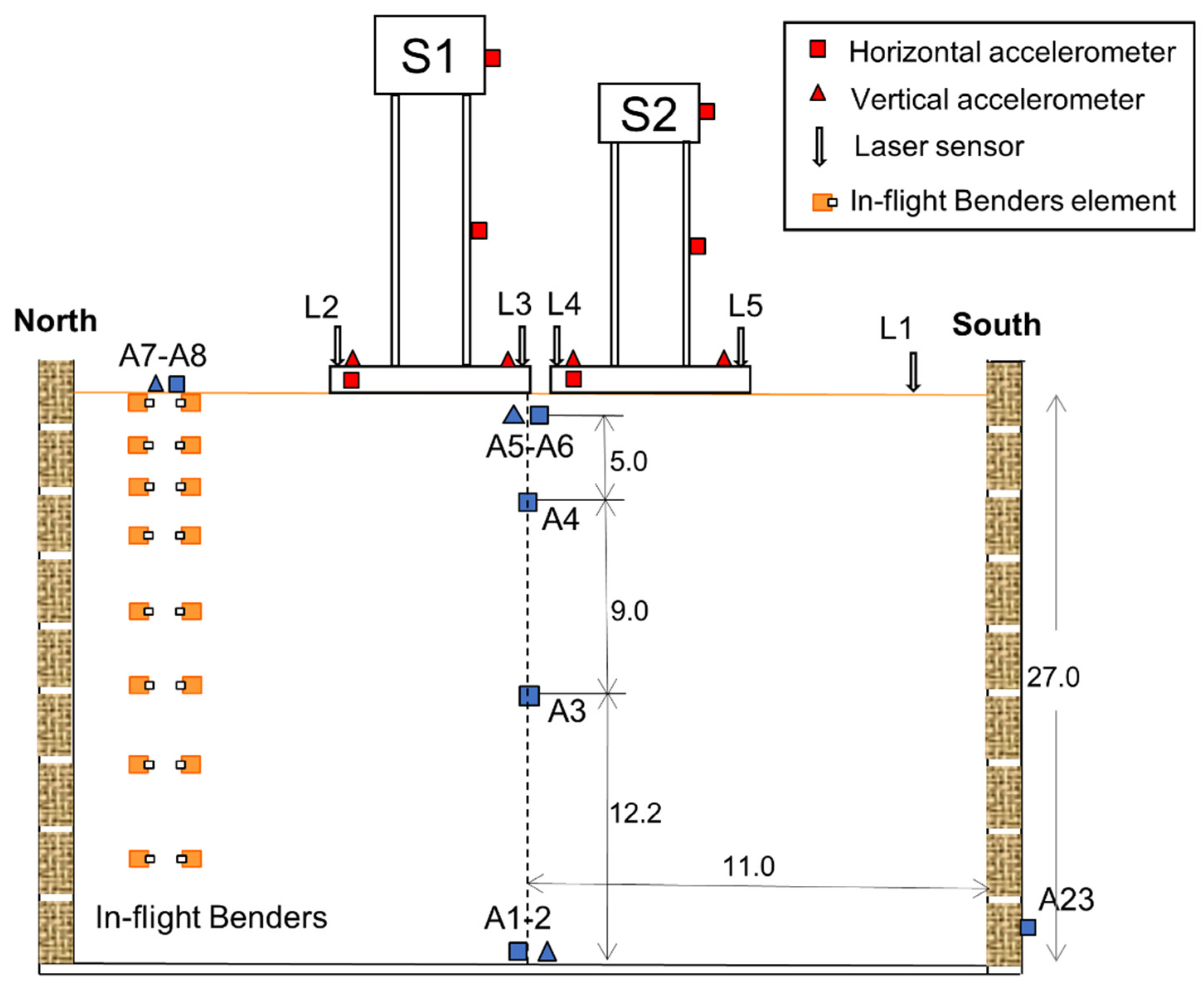

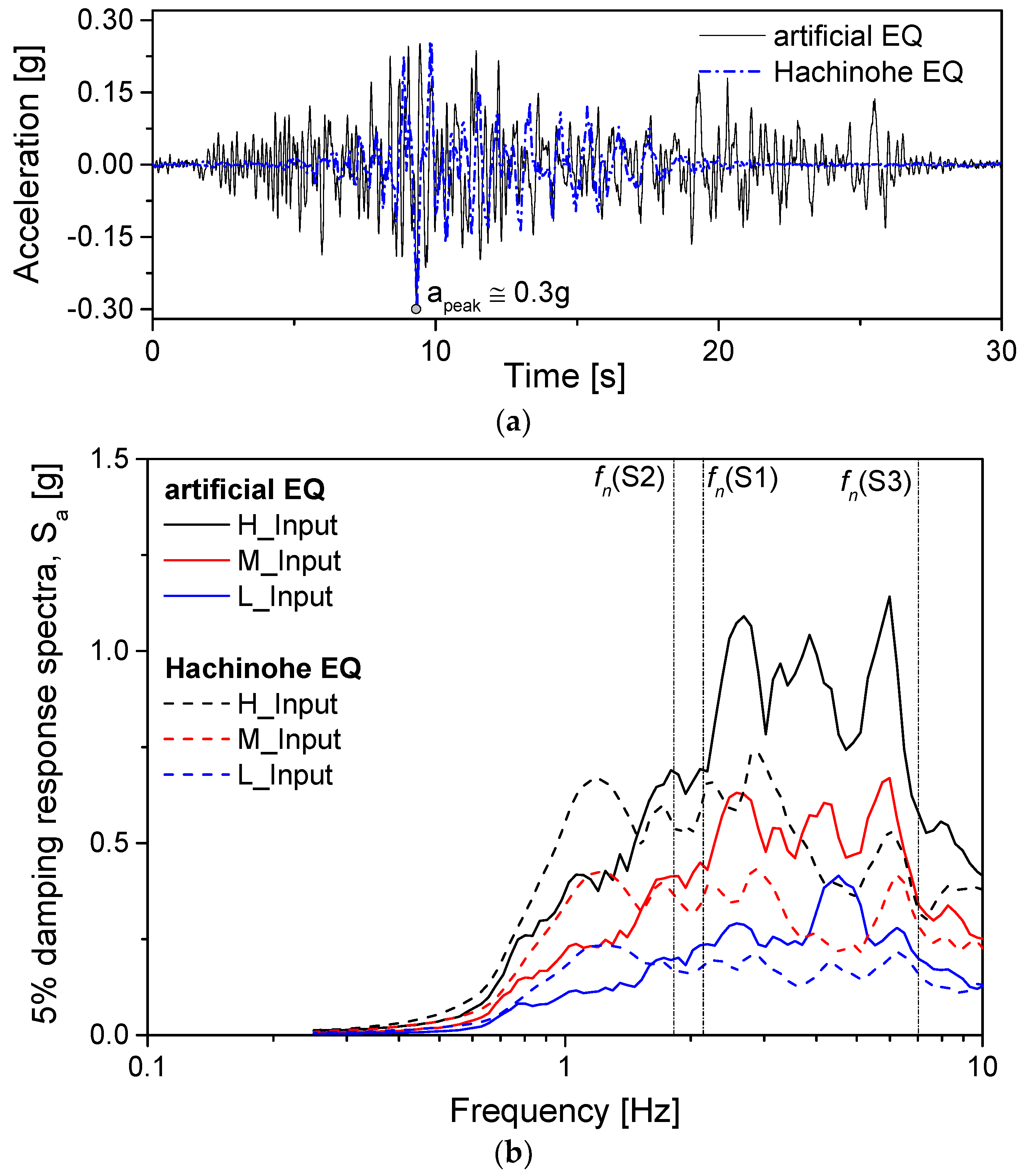
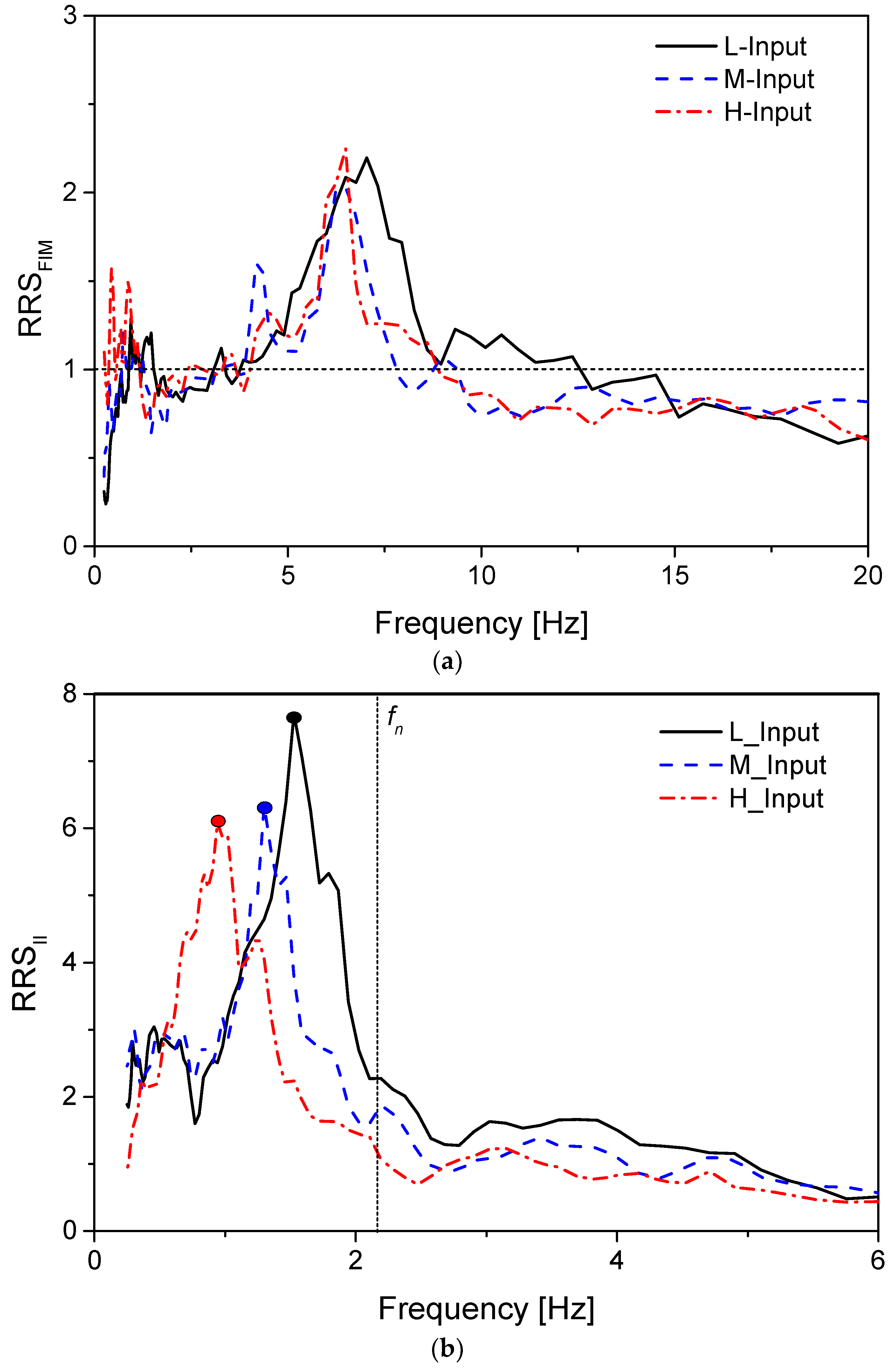

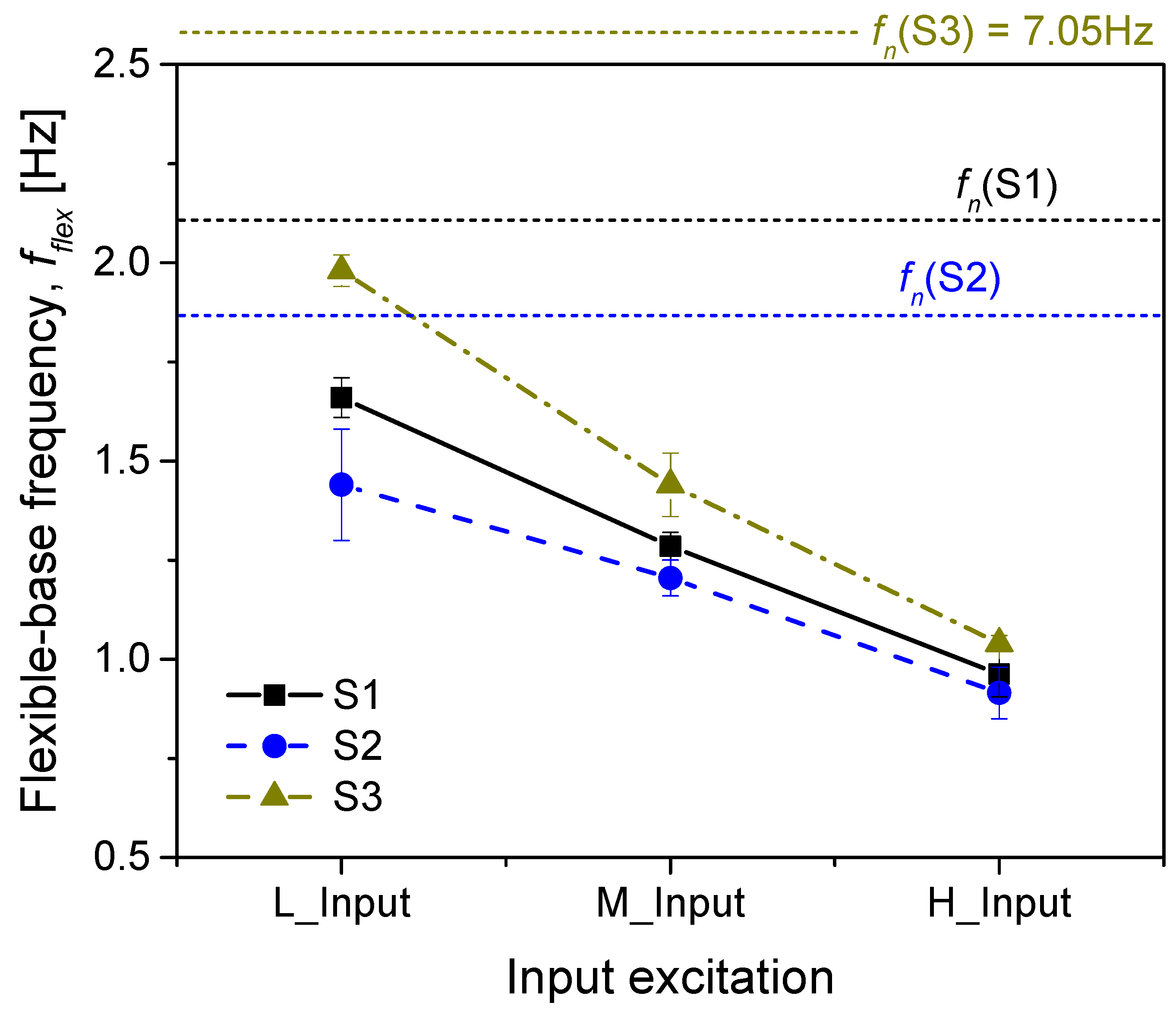
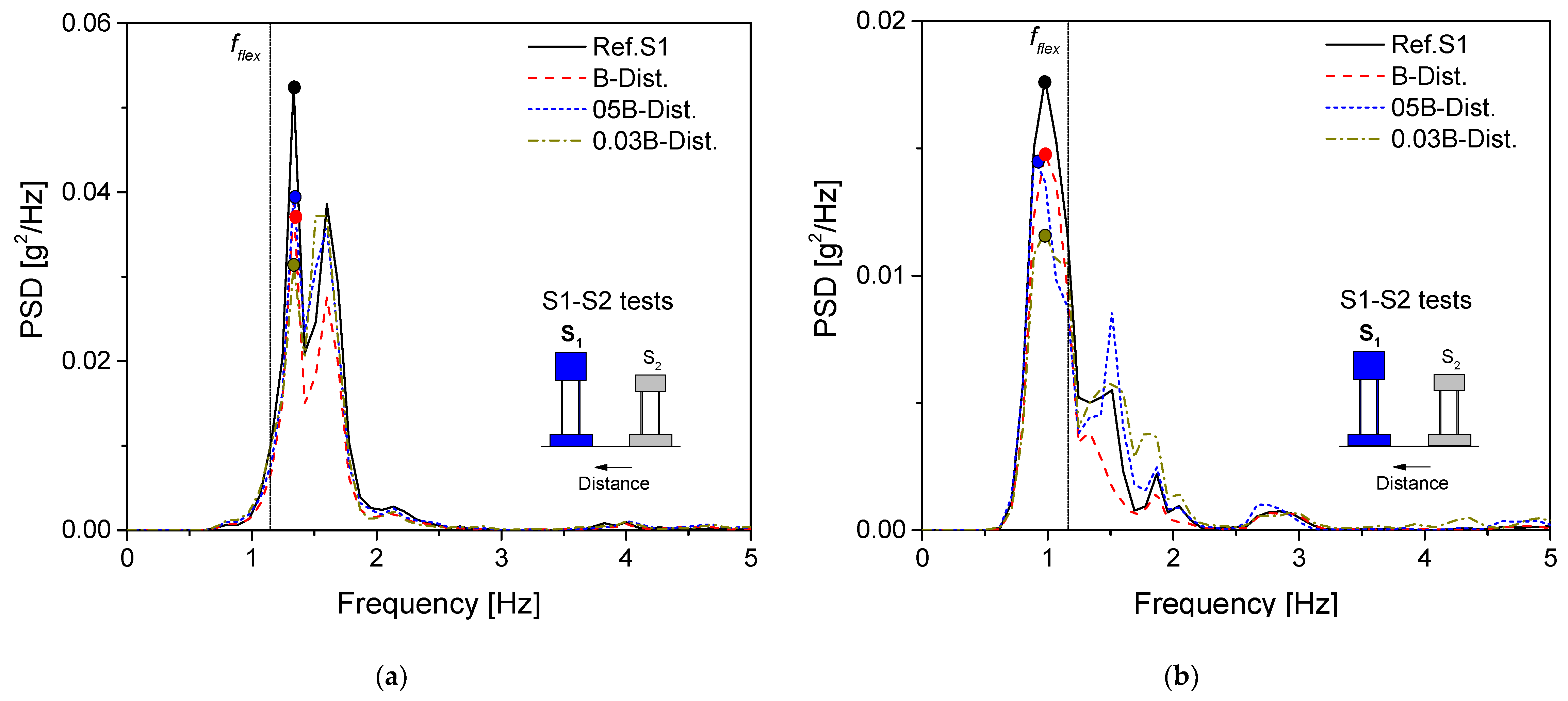
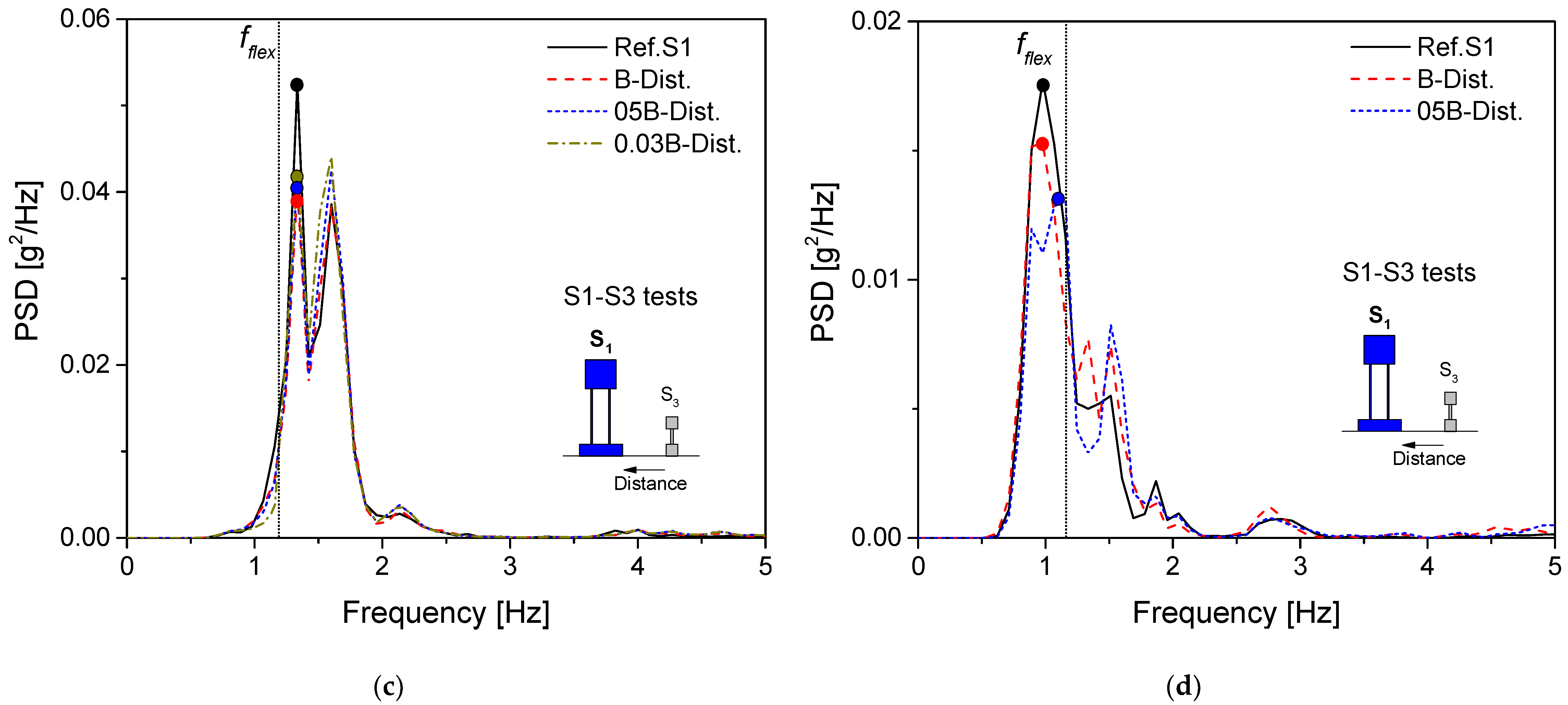
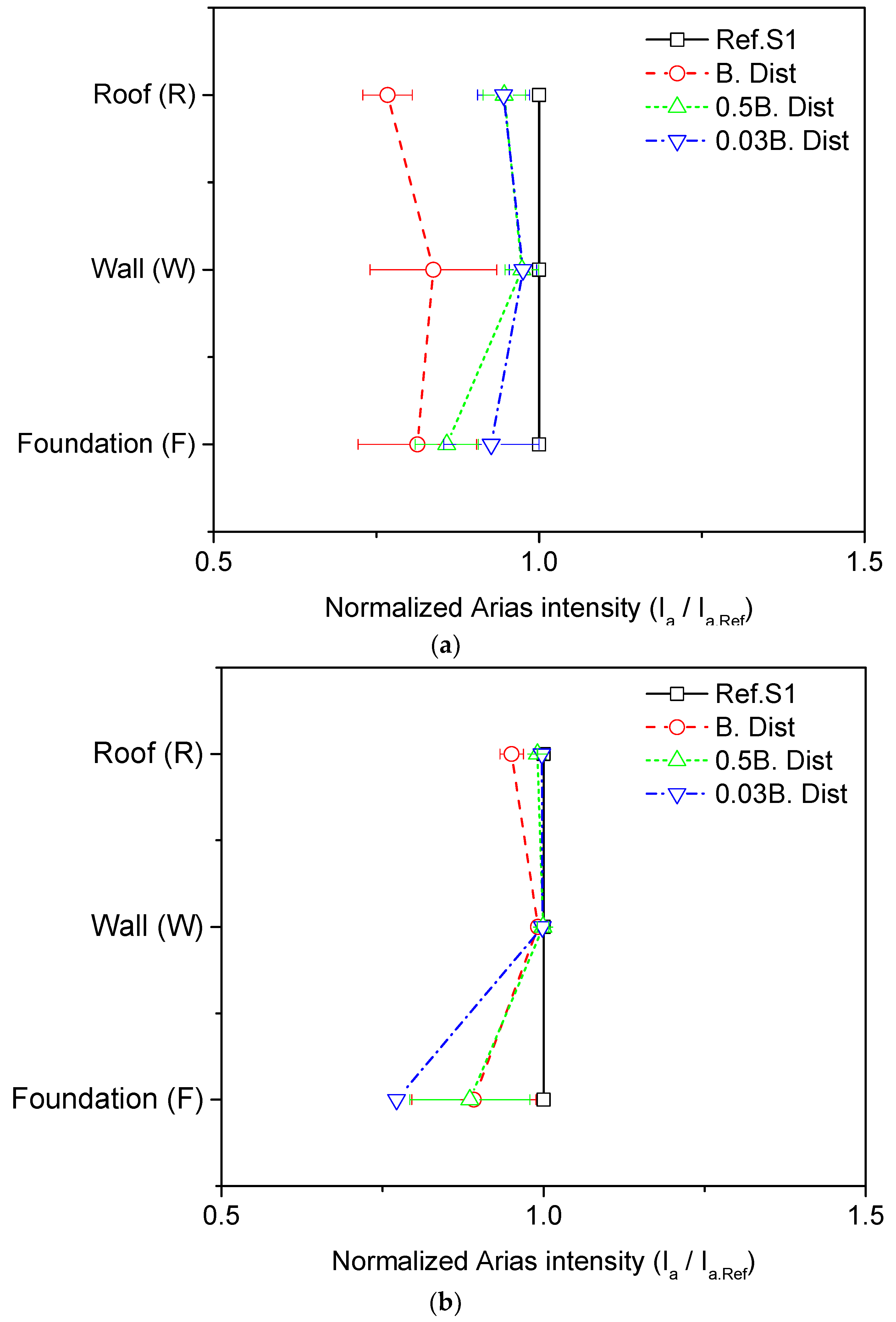
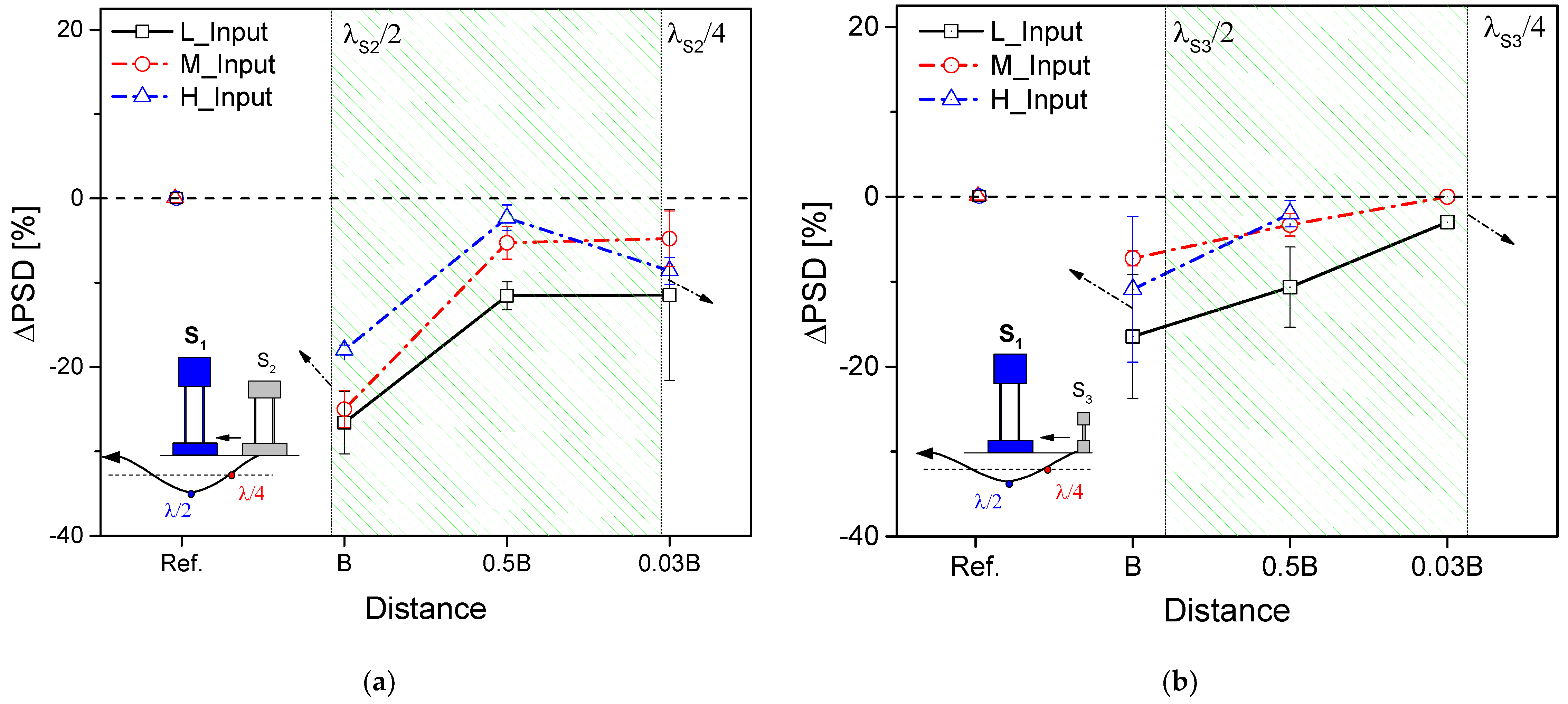
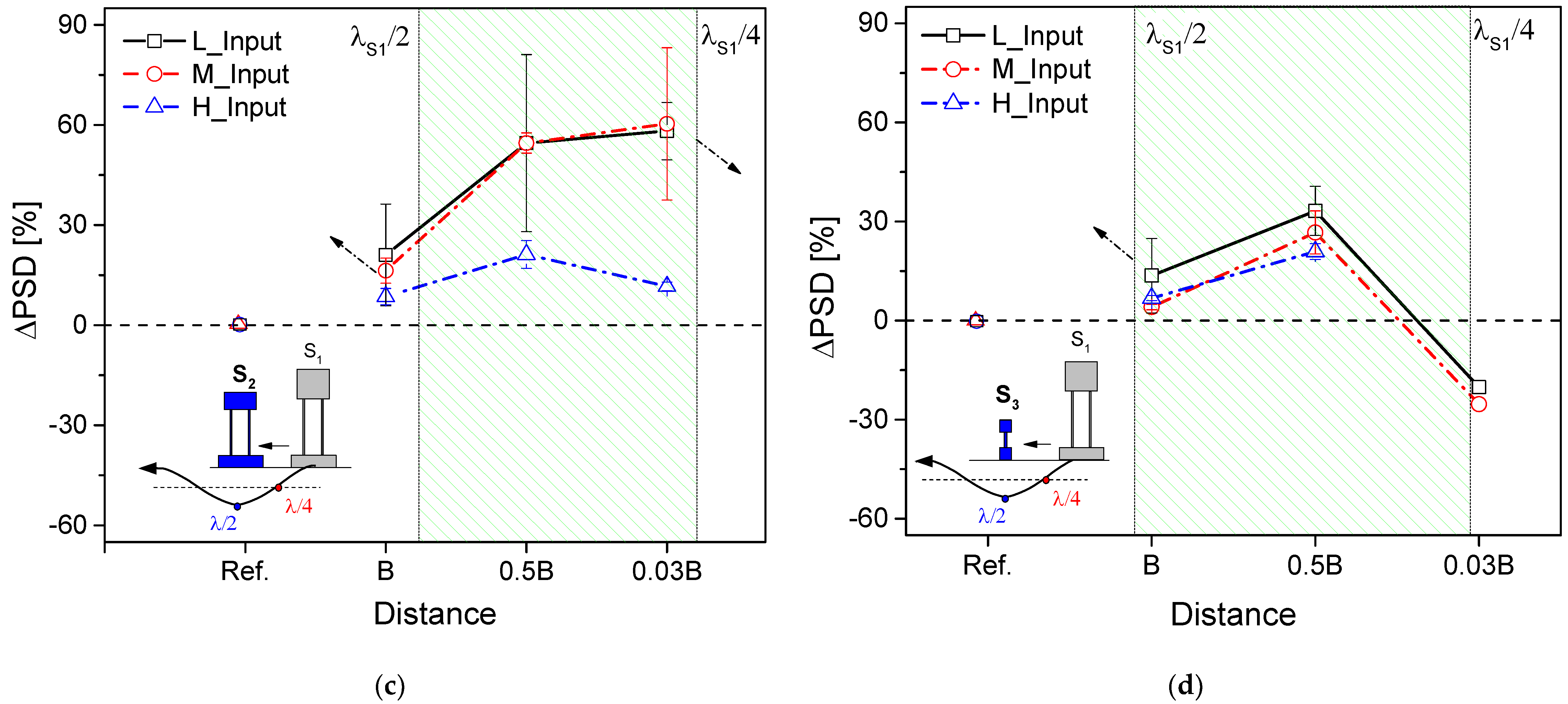
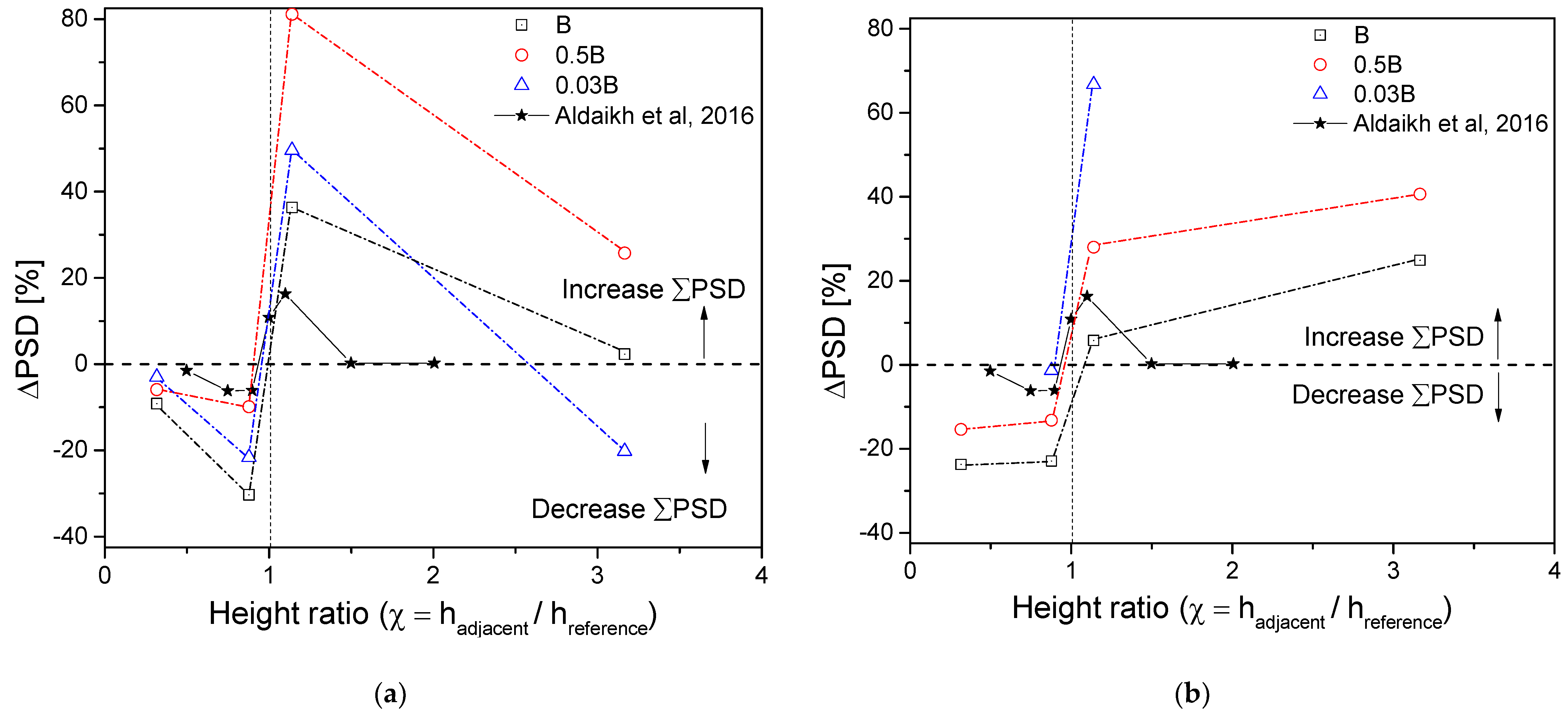
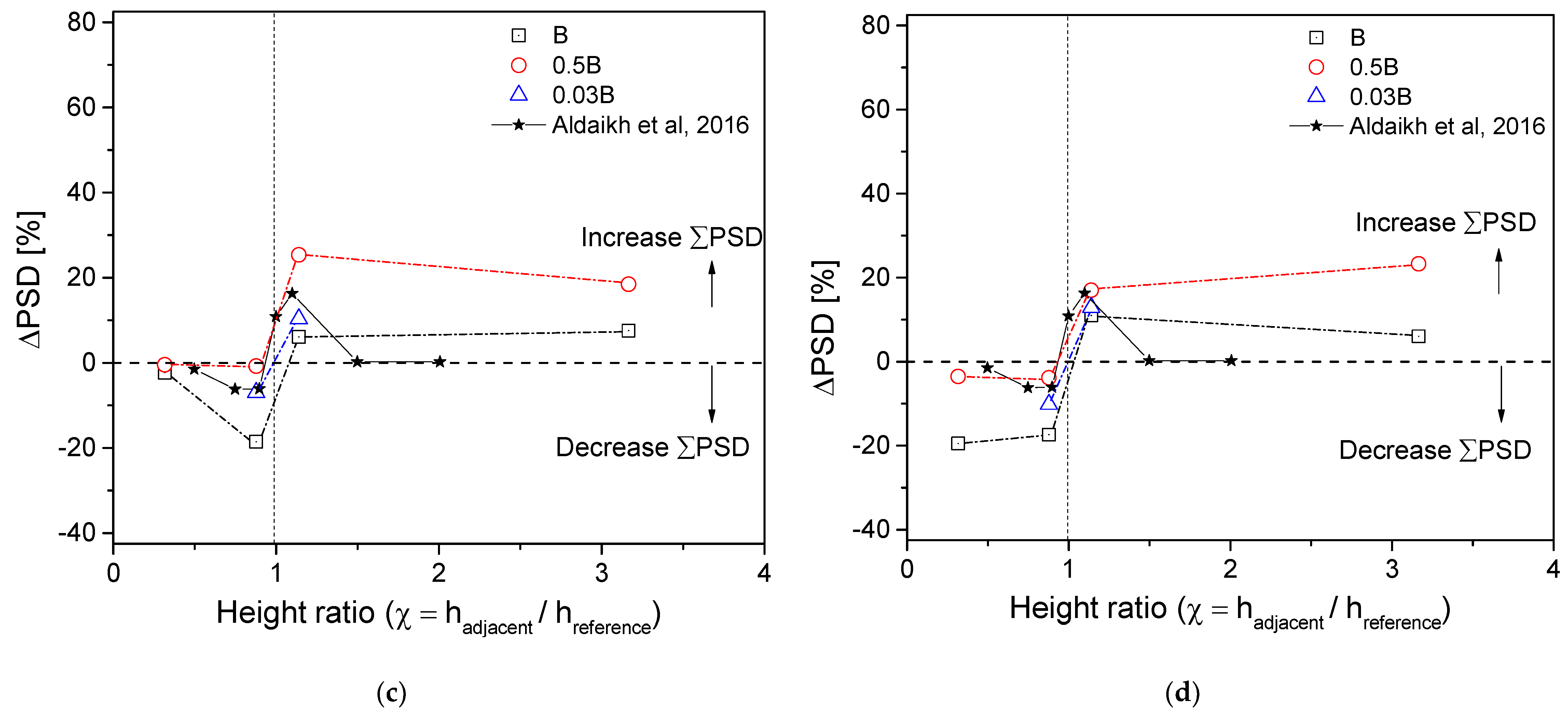
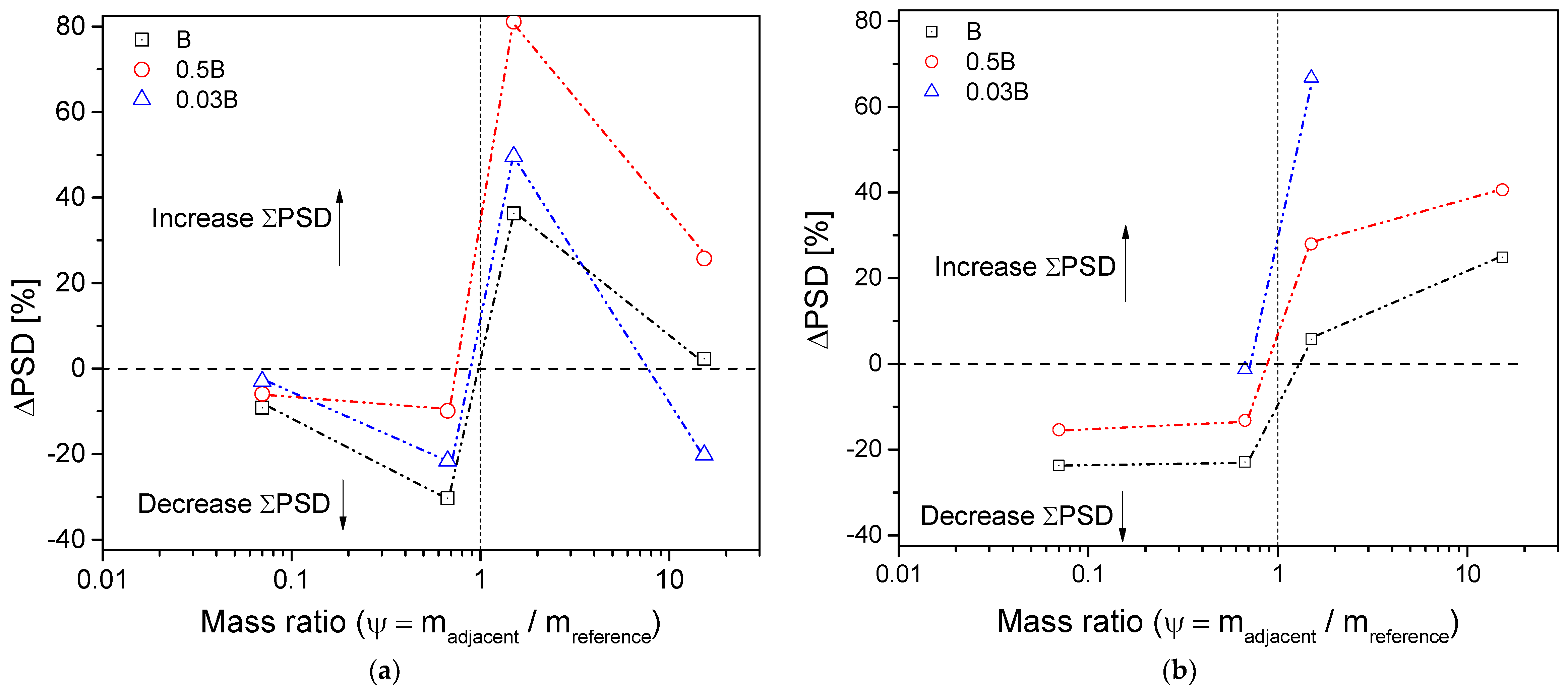
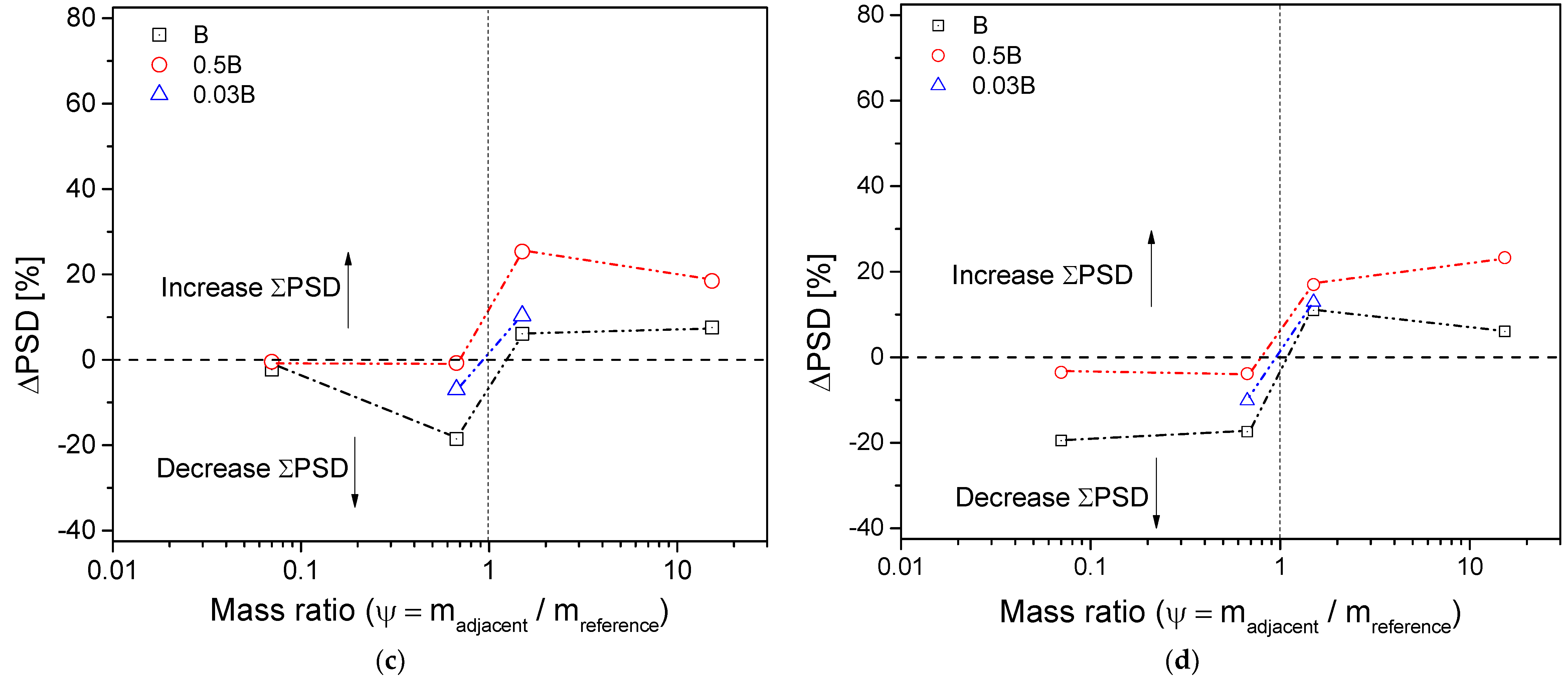
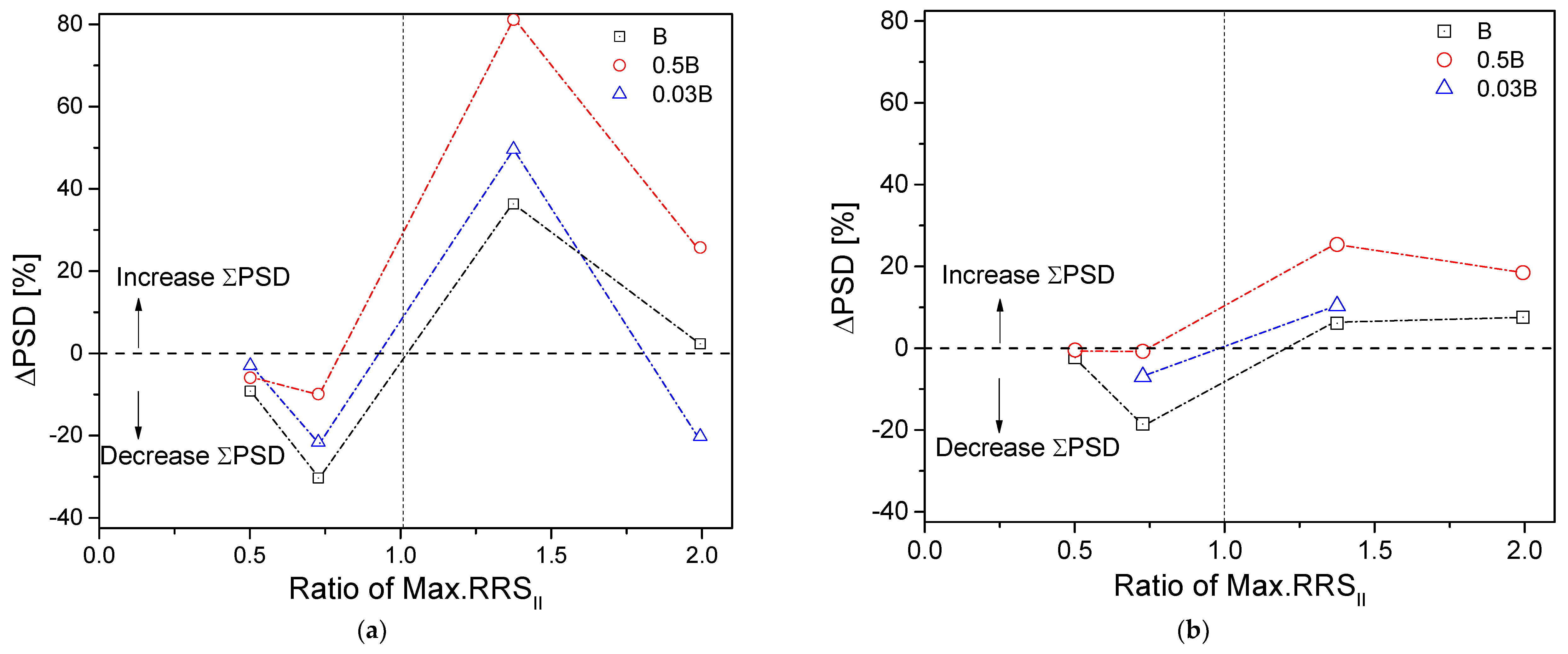
| Structures | S1 | S2 | S3 |
|---|---|---|---|
| Dimensions at prototype scale (m) (Dimensions at 1 g) (mm) |  | 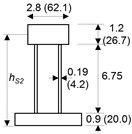 |  |
| Foundation dimensions: Width (B) × Length (L) × Thickness (T) (m) | 5.2 × 5.2 × 0.9 | 4.1 × 5.2 × 0.9 | 1.2 × 2.0 × 0.9 |
| Foundation equivalent radius, rf (m) | 2.95 | 2.61 | 0.82 |
| Height, h (m) | 9.4 | 8.25 | 2.97 |
| Mass at 1 g, m (kg) | 1.89 | 1.25 | 0.13 |
| fn,model at 1 g, (Hz) (hammer test) | 98.6 | 82.04 | 317.4 |
| fn at 45 g, (Hz) | 2.19 | 1.82 | 7.05 |
| Mass ratio, ψ = mS1/m | 1.0 | 1.5 | 15.3 |
| Height ratio, χ = hS1/h | 1.0 | 1.14 | 3.16 |
| Factor of safety, FSv | 19.6 | 22.5 | 23.1 |
| Properties | Value |
|---|---|
| Specific gravity, Gs | 2.65 |
| Fine contents passing #200 (%) | 0.9 |
| Maximum void ratio, emax | 1.137 |
| Minimum void ratio, emin | 0.616 |
| Uniformity coefficient, Cu | 1.6 |
| Soil classification, USCS | SP |
| Relative density, Dr (%) | 80 |
| Dry density (t/m3) | 1.54 |
| Friction angle, φ (deg.) | 36.6 |
| Case | Distance | Remark | ||
|---|---|---|---|---|
| B | 0.5B | 0.03B | ||
| Ref. S1, S2, S3 | − | − | − | Three reference tests for S1, S2, S3 |
| S1-S2 | √ | √ | √ | S1 + S2 structures |
| D (m) | 10.4 | 7.8 | 5.4 | |
| S1-S3 | √ | √ | √ | S1 + S3 structures |
| D (m) | 8.8 | 6.3 | 3.8 | |
| ΔPSDS1 (%) | Artificial EQ | Hachinohe EQ | ||||
|---|---|---|---|---|---|---|
| L_Input | M_Input | H_Input | L_Input | M_Input | H_Input | |
| S1-S2 case | ||||||
| B-Dist | −30.30 | −27.18 | −18.54 | −22.90 | −22.81 | −17.40 |
| 0.5B-Dist | −9.88 | −7.20 | −0.77 | −13.21 | −3.31 | −3.83 |
| 0.03B-Dist | −21.61 | −8.05 | −6.97 | −1.31 | −1.48 | −10.16 |
| S1-S3 case | ||||||
| B-Dist | −9.17 | −6.35 | −2.31 | −23.72 | −8.15 | −19.48 |
| 0.5B-Dist | −5.91 | −2.01 | −0.45 | −15.37 | −4.61 | −3.54 |
| 0.03B-Dist | −2.99 | −0.01 | − | − | − | − |
© 2019 by the authors. Licensee MDPI, Basel, Switzerland. This article is an open access article distributed under the terms and conditions of the Creative Commons Attribution (CC BY) license (http://creativecommons.org/licenses/by/4.0/).
Share and Cite
Ngo, V.-L.; Kim, J.-M.; Chang, S.-H.; Lee, C. Effect of Height Ratio and Mass Ratio on Structure—Soil—Structure Interaction of Two Structures Using Centrifugal Experiment. Appl. Sci. 2019, 9, 526. https://doi.org/10.3390/app9030526
Ngo V-L, Kim J-M, Chang S-H, Lee C. Effect of Height Ratio and Mass Ratio on Structure—Soil—Structure Interaction of Two Structures Using Centrifugal Experiment. Applied Sciences. 2019; 9(3):526. https://doi.org/10.3390/app9030526
Chicago/Turabian StyleNgo, Van-Linh, Jae-Min Kim, Soo-Hyuk Chang, and Changho Lee. 2019. "Effect of Height Ratio and Mass Ratio on Structure—Soil—Structure Interaction of Two Structures Using Centrifugal Experiment" Applied Sciences 9, no. 3: 526. https://doi.org/10.3390/app9030526
APA StyleNgo, V.-L., Kim, J.-M., Chang, S.-H., & Lee, C. (2019). Effect of Height Ratio and Mass Ratio on Structure—Soil—Structure Interaction of Two Structures Using Centrifugal Experiment. Applied Sciences, 9(3), 526. https://doi.org/10.3390/app9030526






